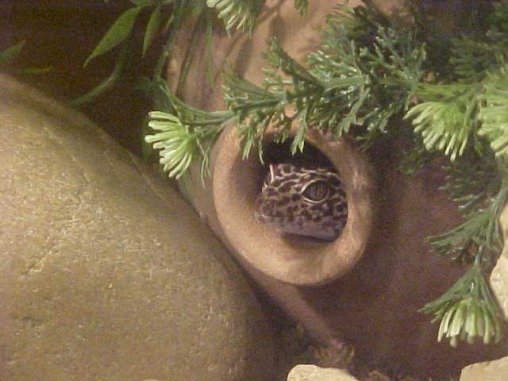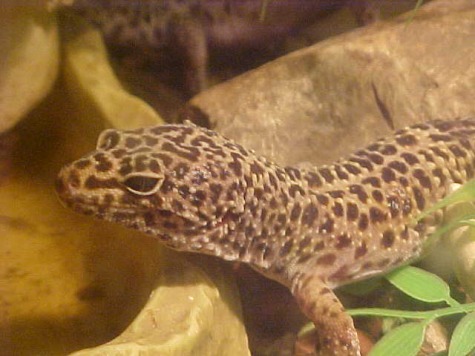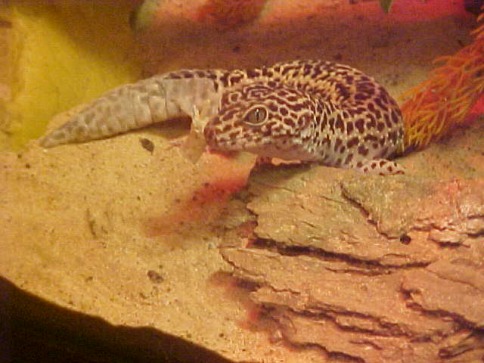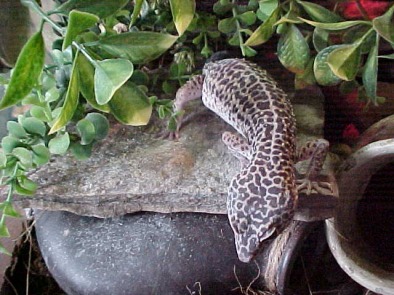The information on the BambooZoo site is as much as 10 years old and in the hobby much has been learned. Though, I believe there is merit in keeping the site open. There are many controversial issues presented in these pages. Please view BambooZoo as a starting point in your research.
These beings are as complicated as we are and deserve more than a basic 5 paragraph care sheet to maintain their health and well being.
My passions have evolved. This is is the site I am growing today. We Heal the World
LEOPARD GECKOS
www.jmillerwordworks.com
Leopard geckos are known as the eyelid gecko. They are one of the few gecko species that can blink, and do not have toe pads. They have claws oN each foot and cannot scale glass, but are still decent climbers.
There are hundreds of different morphs and colors leopard geckos can be found in. The nicer the color and pattern, the more they will cost. Recently Ron Tremper has had success in creating a green pigment in leopard geckos. Even though there are many colors, there are some things that stay the same in all leopard geckos.
The eyes of a leopard gecko are interesting. The pupils are small slits during the day, much like a cat’s. Some albinos have all red or all black eyes, but prices for these can get a bit high. Overall a leopard gecko is a beautiful animal to look at, and will not displease you hen it comes to looks.
Their tails are unique because they are used to store fat and water in case of lack of food or a drought comes by. A leopard gecko tail should be fatter in the middle than at the base, and will come down to a point. Leopard geckos can drop their tails, but the new ones that grow back never look as nice as the original. These regrown tails will be shorter, and much fatter. Losing and regrowing a tail does not hurt a leopard gecko at all.
Leopard geckos have interesting ears. They are simply holes on each side of their head. You can actually see their eardrum and farther if the stay still. Even though they do not look sophisticated, leopard geckos have very sensitive ears. Their mouth has a tongue that has a special capability. You may notice they flick their tongues out when they are somewhere different. This is because the have the Jacobson’s Organ. This allows them to pick up scents with their tongue. This gives them a very acute sense of smell. They can tell with their ears and smell when you enter the room and will know if a stranger with a different sound and scent comes along.
Leopard geckos are fairly small reptiles so their tank does not have to be big and expensive. A hatchling can live in a 5-10 gallon tank, but if they seem cramped then upgrading to a 20 gallon tank is a good idea. 10 gallons is the absolute bare minimum for an adult leopard gecko. 20 gallons is much preferable. Since leopard geckos do not have sticky toe pads like tropical geckos a longer tank should be used over a tall one. Leopard geckos will not use the height unless large branches and other decorations are provided for them to rest on.
It may seem like leopard geckos are lazy, sleepy geckos but this is because they are nocturnal. This means they need at least three hide boxes throughout the tank. These hides should be snug. They need to let your gecko feel safe and secure, but not cramped. A hide on the warm side, the cool side, and a humid hide should be found in the tank.
Your leopard gecko will not care how fancy or how inexpensive your hides are as long as they work. A flipped, cleaned out butter container will work just as well as a $20 clay molded hide. Two of these hides need to be on opposite sides of the tank so your gecko can thermoregulate while staying hidden during the day.
The third hide is the humid hide. This hide aids in shedding, and keeping your gecko hydrated. In the wild leopard geckos find moist holes in the ground to lie in and rest if over hot or if they need more moisture. This hide does not have to be high-tech either. The only thing different about this hide is that it should have sphagnum moss or paper towels. Whichever you choose, be sure it is always moist and providing a moist, not soaked retreat for your leopard gecko.
Now into decorations and all of those little extras. Thick, study branches and logs can be propped up so your leopard gecko has something to climb on. They are fairly good climbers even lacking those toe pads. Plastic plants can be bought and put throughout the tank as well. Live plants are not suggested because the will increase the humidity of the tank too high and resipitory infections can occur.
Rocks and other objects can be added to give your leopard gecko something to explore. If you bring things in from outside, be sure to sterilize them well. Diseases, insects and toxins can be found on them unless sterilized.
DIET
Leopard geckos are insectivores, meaning they will take insects. They do not need fruit or vegetables, and they will not be taken. There are a few different things you can feed a leopard gecko, and I will explain them to you. There are many insects such as crickets, mealworms, king worms, silk worms, wax worms, and phoenix worms. These are the main insects found at pet stores, and I will talk about the nutrition of each of them.
As for the amount of food, feed babies and hatchlings still growing every day. Once they reach 9 months old they only need to be fed a couple times a week. Some leopard geckos will be eager to eat just about anytime while others just won’t eat as much. Most of it is personality, and as long as their tail isn’t too skinny you shouldn’t have to worry. Give them as many insects as they will take in 10-15 minutes. Be sure to remove any leftover insects so they do not bother your gecko.
Dust prey items with 100% calcium supplement to keep your leopard gecko’s bones strong. Babies need a dusting every feeding while adults only need a dusting once a week. A milk cap filled with this calcium can be kept in the tank and if they feel they need more, they will go over and lick it.
Variety is important because if you only offer mealworms, there may be too much of one mineral and not enough of others. They will survive off of only one insect, but they will not be their happiest and most satisfied if you do so.
Let’s start with crickets. Crickets are a great staple diet with lots of protein, and relatively thin exoskeletons. They are a common food source and any pet store that sells reptiles will have crickets. You can purchase many sizes of crickets from pinheads, or newly hatched to full grown adults measuring an inch long. There are also commercially made crickets keepers, but you can easily make your own.
Take a plastic tub with a screen lid and fill it with paper towel roles and pieces of egg carton for the crickets to hide on. Be sure to feed the crickets and pack them with good nutrients because whatever goes into your crickets will go into your gecko. Clean the cage when needed.
Next up, meal worms. Mealworms are a good food source, especially for baby leopard geckos. You can choose which size you want, and they are not as fast and jittery as crickets. The main downside is that they have a thick exoskeleton so most of the worm will pass through the body without providing the cells with as much nutrients. Leopard geckos may eat many of these because they are fairly light. Mealworms can be kept in a container with oats and carrots. Remember to clean the container.
Much like the mealworm, the king worm will be taken. Do not feed these larvae to leopard geckos less than 6 months of age because they are much too big and may even harm it. They can get 3 inches long, and have a much thinner exoskeleton that mealworms. King worms are packed with nutrients and make a great addition to your gecko’s diet. King worms will also live in oats and eat carrots and potatoes.
Silk worms are probably the healthiest insects available on the market. They are soft, much like a caterpillar and are packed with everything a leopard gecko needs to thrive. Normally silk worms have to be bought online, and with their own special food. This is their downside. They require a certain food that can be bought moist or dried and you add water. Without this food, they will day within a couple days and will not be as healthy or filling for your gecko.
Phoenix worms are slowly becoming a more popular worm to feed reptiles and amphibians. They have a long life before turning into a moth, and do not require too much attention. They are also available mainly online for a good price. As more information comes out about them and the word spreads, they will become as popular as the meal worm.
Lastly, wax worms. Wax worms are a great treat, but should not be fed because of their high fat content. These are good for females getting ready to lay eggs. 3-4 of these little guys a week can be provided, and wax worms will eat carrots and potatoes as well.
I said above that leopard geckos need a 100% insect diet. You can break this rule with pinky mice on occasion. These mice can be fed maybe twice a months and will certainly fill your gecko up and pack them with lots of good proteins and minerals. These are also great for preparing females to lay eggs. With pinky mice fatty liver disease is a possibility so caution should be taken.
Watching geckos attack and devour their food is an entertaining site to watch. Since they are nocturnal, they will hunt more at night.
SUBTRATES
Substrates is an important part of a leopard gecko’s habitat. In the wild they live on compacted dirt with little wisps of sand blowing around. In captivity, there are many substrates that will work for this species.
Paper towel is popular because nearly every household has it, and it can be bought for a very low price. They also are great for cleanup. You simply remove them and replace with fresh paper towels.
Similar to the paper towel is newspaper and butcher’s paper. When using these, make sure the ink has completely dried out so it does not pose a problem for your leopard gecko. This is a great chance for you to say you recycle! There is also reptile carpet, which will also work fine, but watch for claws stuck in it.
There are also loose substrates. These substrates should be used for adult geckos only because impaction can occur if a baby swallows too much. These substrates are much nicer looking and do not need to be replaced as often.
Sand is a popular loose substrate. It can be bought at most pet stores. Be sure to fill the tank 2-4 inches full because some leopard geckos will dig. Sand needs to be replaced every couple of months. Watch your leopard gecko when hunting because that is when they will swallow some sand. Sand is also known to cause eye irratation. Despite all these possible problems that may occur, many keepers have had leopard geckos kept on sand for their entire lives with no problem. Small pooper scoopers can be bought and used to clean the tank of feces and dead crickets.
There are some sands to avoid, however. Many pet stores sell sand called calci sand or other sand that is made up of calcium. They say if this sand is ingested then it will go straight through the body and impaction is no longer a problem. Unfortunately there have been very many horror stories about this sand.
If owners are not providing enough food or calcium then the geckos may start eating the sand. Soon so much sand is digested that instead of going through their system it turns to a toxic mush blocking anything from coming out. This is where owners fine problems.
There are also many keepers who have had success with this sand and have never experienced and problems. Recently the makers of this calcium-based sand have worked to improve the problems many owners have had. This calcium sand is getting better and fewer and fewer problems are arising. If you choose to steer clear of calci sand then playground sand that has been sterilized will work just as good.
There are many other things that can be used like soil, mulch, and corn cob bedding. Avoid these because they can be harmful if swallowed, and may make the tank too humid.
Choosing the right substrate is important because it is what your gecko will be living on their entire lives. Good substrates include reptile carpet, paper towels, newspaper, butcher’s paper, and fine sand.
LIGHTING AND HEATING
Leopard geckos are ectotherms meaning they are cold blooded. They require external heat to be able to digest food, move and stay alive. Too little heat, and their body will stop working, and too much heat will make them stressed, raising their body temperature too high. Over heating is much worse than under heating. Over heating will kill a gecko, under heating will slow it down, which is still not a good thing. The trick is to find the perfect temperature, or let them find it.
There should be a basking spot of 92F on one end of the tank. This can be accomplished with either a under tank heater (UTH) or an overhead bulb. The difference is that the bulb will heat the air while the UTH will heat the substrate. UTH’s are great for leopard geckos because they absorb 90% of the heat their body needs through their underside. Considering they do not have sticky toes pads letting them climb, air temperature is not a problem. A UTH will last a year or two while a bulb may last a couple months. Whichever you choose, be sure that the right temperature is achieved.
There is a raging storm, shingles popping off your house one by one. All of a sudden you hear a splintering crash and a tree has knocked your power lines. All you are thinking about is heat for your leopard gecko. You race to the cage, expecting it to be on its back, dead. Luckily, you do not have to worry about your leopard gecko suffering too much. You really only need to start worrying if they are without the proper heat for more than 3 days. Do not worry leopard geckos are hardy reptiles.
Now that you have the basking spot in place you will need to know the temperature of the other half of the tank. The rest of the tank does not have to be heated at all. This will give the gecko a choice of temperature. Leopard geckos are the official thermometers of these ends. If you notice a leopard gecko only on the warm side, the heat may need to be increased. Vice versa with the cooler end. It is still a good idea to have a thermometer on both ends to monitor the temperatures.
Now onto the topic of UV lights. UVA and UVB lights are made to copy the sun’s role. They allow reptiles to soak up the required vitamin D3. Since the leopard gecko is a nocturnal animal and will hide most of the day, UV bulbs are not required. The insects they eat should hold the nutrients they need.
There are heating devices on the market called hot rocks. They are made for reptiles, and go inside the cage for them to lie on. Using these with leopard geckos is a bad idea because burns will occur. For some odd reason, leopard geckos have very insensitive undersides and very sensitive backs. This is simply the way they are built. This means that a leopard gecko will not feel the burns until the scales have been melted away. Some people have not had problems with them, but it is not worth the risk. If you look online there are many stories about hot rocks going bad and killing reptiles.
WATER AND HUMIDITY
Leopard geckos are from desert-like areas. They do not require much water and humidity. Their tank does not ever have to be misted, and as long as a humid hide and a water bowl are available they will be just fine. The water bowl can be fairly small and the will not lay in it like other reptiles. Be sure this water stays clean and is replaced daily. Using the right type of water is important. Tap water should not be used because it contains chlorine and other dangerous minerals. There are cleaning solutions you can buy if tap water is the only water available to you. The better option is bottled water. Since they don’t require much water, a single bottle will last about a week. Buy water that is straight from glaciers or natural springs. Water purified through reverse osmosis is acceptable too.
Water requirements are fairly easy to achieve with this species, but are still necessary for your leopard gecko to thrive.
MY OWN LEOPARDS

Knowing what I know today, if the question were asked of me, should I get a beardie or a leopard gecko? The leopard gecko is as beautiful and as personable as a bearded dragon. They require less space, less expense, they are fastidiously neat, soft as velvet and as tamable or as solitary as you would like them to be. Very calm though can pack a whollop of a bite if they get into a disagreement with a fellow leopard. Although nocturnal by nature they will and do come out during the day, most especially for a meal. The moment they hear me pop the grill on the top, heads poke out of their hide. The simple pottery pot with a small opening has followed them from home to home here. They love it.
This pair is 10 years or just a little older. These are an excellent beginner lizard and available often through classified ads at a very reasonable price. They have many fewer requirements than beardies and are usually hardy and happy guys. They need 1 quarter the size environment that a bearded dragon will require when grown. Their skin is as soft a velvet, an incredible feel to it. They don't need lighting changes preferring ground heat both inexpensive, and not taxing to the environment. There are 2 possible drawbacks to keeping the Leopards that can be summed up in one sentence: Plan on providing live food for up to 20 years.
If proper husbandry conditions are maintained including humidity and heat they can be relatively trouble free. Pay particular attention to: the substrate you use, sand can cause eye irritation and impaction, other substrates are also known for impactions. Not keeping a moist hide area can result in bad sheds and could lose a digit or tip of tail. Leopards can and do quite often drop their tails from traumas. They are not going to be themselves for a few days. They can be placed on paper towel with their usual hide, an antibiotic cream can be used. Be careful they are not licking it off. A safer method is Aloe Vera gel which will not harm them if swallowed and is famous for its healing properties.
ALL lizard babies need to be fed daily. 2 to 3 times a day in some cases.
Leopards can be housed in natural settings easily, because of their fastidious nature, they will eliminate in one small area making clean up a breeze and fewer full substrate changes. Provide levels in their tanks and you will get rewarded by seeing them climb often.
SHARED ENVIRONMENT WITH THE STAR
RELATED PAGES
EGG CARTON/PAPER TOWEL ROLL DIY FURNITURE
LEO VS. LOCUST
THE PROS AND CONS OF DIFFERENT SUBSTRATES
CRYPTO A LIFE TAKING DISEASE
TAIL INJURIES
EASY HIDE PROJECT
BRINGING HOME HATCHLINGS
OTHER HEALTH INFORMATION SOURCES
RESOURCES
http://www.leopardgecko.com/ Ron Tremper's Site. One of the respected experts.
http://www.vmsherp.com/LCKeepingLeopards.htm
http://www.vmsherp.com/ViewLeopards.htm
http://www.leopardgeckocare.net/
http://www.thegeckospot.com/careindex.html
http://www.geckosetc.com/index.html
http://www.drgecko.com/index.html
http://www.thegeckospot.net/leohealth.php
http://www.albeysreptiles.com/incubate-eggs.htm
http://www.vmsherp.com/LCLeopardNames.htm
http://www.leopardgeckowiki.com/wiki/index.php?title=Category:Morphs&from=A
http://www.paulsagereptiles.com/index.htm





